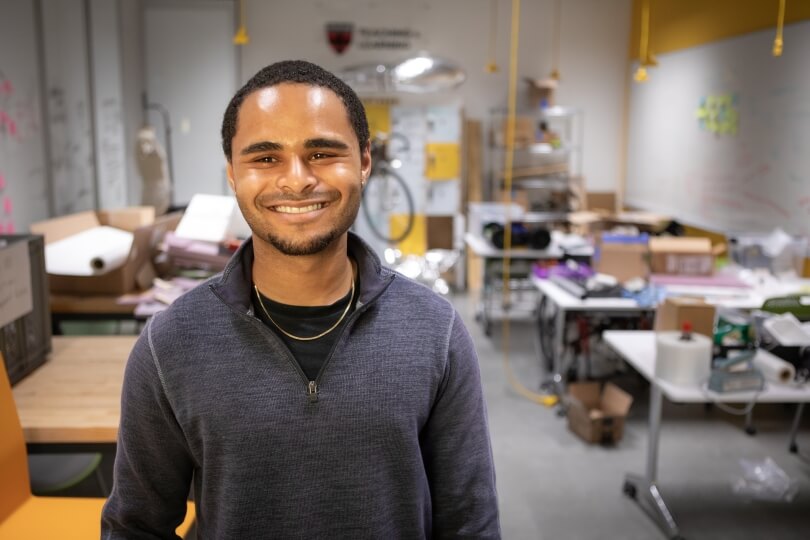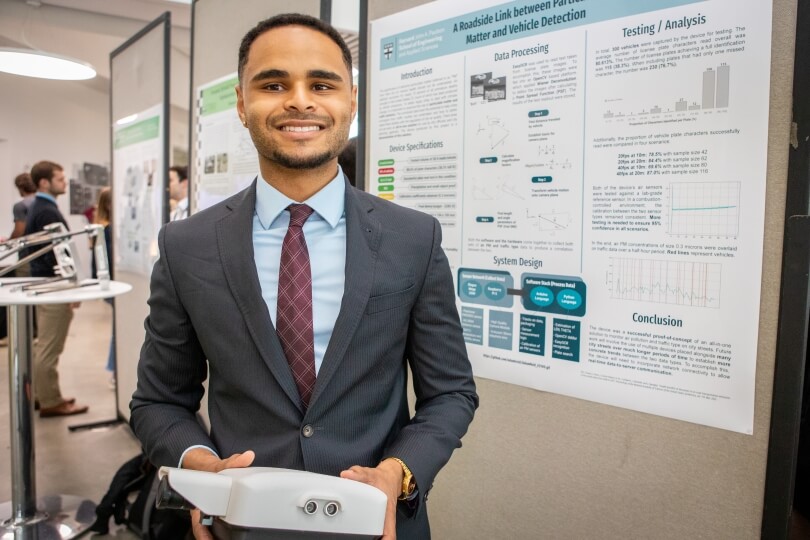Adam Reid, S.B. '24, in mechanical engineering (Eliza Grinnell/SEAS)
Even before he could legally drive, Adam Reid knew he wanted to be an automotive engineer.
“Cars have revolutionized our world,” Reid said. “The day I first got my driver’s license, there was hardly a comparable feeling in the world. To this day, I make sure to surround myself with everything automotive.”
Reid hasn’t lost one bit of that passion over his four years of studying mechanical engineering at the Harvard John A. Paulson School of Engineering and Applied Sciences (SEAS). But after living in a city with accessible public transportation and being so close to green spaces like the walking path along the Charles River, he’s gained a newfound appreciation for the relationship between cars, community and the environment. So even as he’s devoted much of his time to promoting automotive engineering at Harvard, he’s studied ways to make cars more environmentally conscious.
“It’s very difficult to imagine a version of today where we don’t have that type of transportation,” he said. “It’s allowed us to do so much, from police and fire response, to get deliveries to your door, to just being able to travel to relatives who live two hours away. But we can do a better job of thinking about how these vehicles are interacting with our environment.”
The opportunity to study a range of subjects with a diverse group of students brought Reid to Harvard from his hometown in Baton Rouge, Louisiana. He wanted a liberal arts education, one that could pair technical training with humanities education, and to meet people from different backgrounds.
“The biggest thing that I’ll remember from here is being able to meet all these different kinds of people and learn how somebody’s background can be a really big factor in shaping who that person is,” he said. “What I bring to the table is really unique, but I’ve gotten to meet other people and see what they can provide from their background. Being a graduating senior now, I have a feeling this is a pretty special place.”
While here, Reid’s principal extracurricular activity has been the SEAS-affiliated Harvard Undergraduate Automotive Society (HUAS). When HUAS was founded heading into his sophomore year, he applied to join its leadership board. He’s now the technical director for research and development with HUAS, and one of his main projects has been converting a go-kart to electric power. He helped design the LED dashboard, which doubled as a mechanical engineering class project. He’s also served as co-finance director for the Harvard Undergraduate Clean Energy Group, and is a member of the Harvard Undergraduate Urban Sustainability Lab
“The HUAS founders imagined the club as engineering-focused, where students could come to the newly built Science and Engineering Complex to work on their engineering projects,” Reid said. “But by far the most popular thing we do is our Formula One watch parties. You don’t have to know anything about cars. You can just roll up with your friends to watch. We’ve also gone go-karting in the area, and have been trying to build a Formula-style race car.”
For his senior capstone project, Adam Reid designed a device that can monitor air pollution and traffic on city streets, and even classify cars based on type (Eliza Grinnell/SEAS)
For his senior capstone project, Reid designed a device that can monitor air pollution and traffic on city streets, and even classify cars based on type.
“If you had multiple devices, you’d station them around the city to build a map of traffic,” he said. “The hope with this device is that you can not only see the number of cars in an area, but also their type, so you could differentiate an electric vehicle from a sports car. You could have a map of the different vehicle classes in different areas of the city. If you saw on a road that there was a high concentration of more polluting vehicles, like big trucks, the hope is you could see a correlation with increased air pollution over time.”
Outside of SEAS, Reid has spent his summers working in the automotive industry. He started with a job as a part sales expert at a local AutoZone back home, then moved on to consulting with ChargePoint, an electric vehicle infrastructure company that was looking to build more charging stations in Cambridge.
For the last two summers, Reid has worked as a mechanical engineering intern at General Motors (GM). He started in Flint, Michigan, where he developed a system to help sort and optimize the tools used for repairs on production lines. He returned this past summer to work at GM’s proving grounds.
“That’s where they take newly designed prototype cars, a few stages before they’re ready to be released, and test how the various components of the car work and fail before they go out to the market,” he said. “I looked at different types of brakes for vehicles, so I was learning about both vehicle dynamics and how many different computer systems control these components. When you drive a car, you press the brake and it stops. I had no idea just how many different computers are sending signals to each other in milliseconds so that when you press the pedal each time, it brakes exactly the same way.”
Reid will be going back to GM after graduation.
“I’m most interested in trying to figure out how vehicles on the road communicate with each other,” he said. “Going forward, there’s a lot of talk about autonomous vehicles, and the whole industry is trying to move in that direction. Something that’s going to be critical is thinking about how we make sure the vehicles can realize where they are in relation to other cars, pedestrians and other objects. Cars not only need to have the ability to fully drive themselves, but be part of an integrated system like public transportation. As an engineer, it’s really exciting to see what’s out there and what’s possible.”
Press Contact
Matt Goisman | mgoisman@g.harvard.edu

